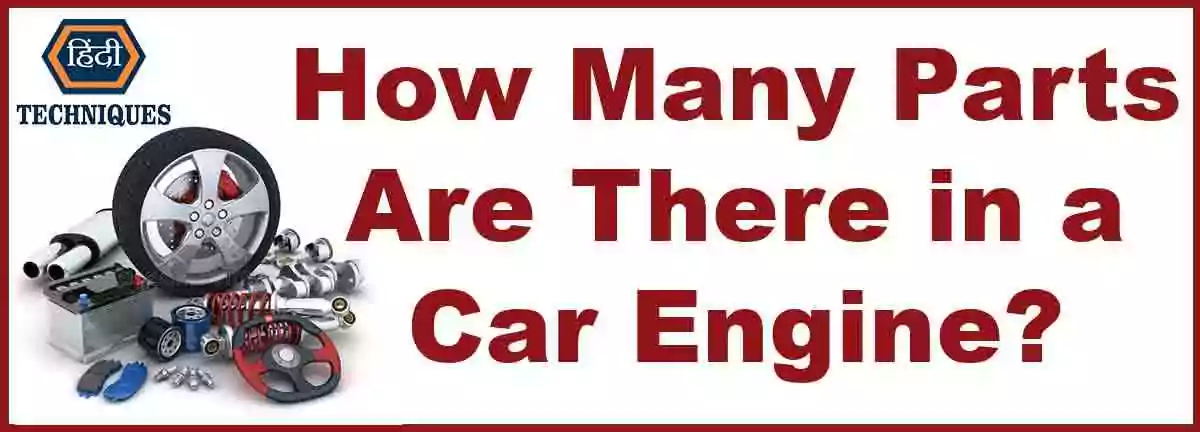Last updated on September 19th, 2023 at 06:35 pm
As we marvel at the complexity and functionality of modern automobiles, the question inevitably arises: Just how many parts are there in a car? The intricate interplay of components in a vehicle is a testament to engineering prowess. In this article, we will delve into the world of car components, explore the numbers behind them, and shed light on some intriguing aspects related to on average how many parts are there in a car.
On average how many parts are there in a car?
We have been giving information related to jobs in our blog Hindi Techniques. But in the previous article, we told you about NSP Scholarship Biometric Authentication. That topic was slightly different. Today we are going to talk about the average number of parts in a car. So today’s topic is also a bit different.
So friends, let’s start the article and discuss in detail how many parts are there in a car. Along with this, many more questions related to this will be answered. Some of which we have given below.
Connected Questions.
- On average how many parts are there in a car?
- How many parts are there in a car engine?
- How many parts are there in an electric car?
- Major Components of a Car: From Chassis to Body.
- What are the parts inside the car?
- What are the parts of a car wheel?
- What are the parts of a car air conditioner?
- Are car parts expensive?
- Are car parts allowed on airplanes?
- What car parts are illegal?
- Are car parts duty-free?
- Are car parts interchangeable?
- how many parts does the average car have
- how many individual parts are in a car
On Average How Many Parts Are There in a Car?
When you step into a car and take a drive, you might not realize the intricate web of components working together to create a seamless driving experience. An automobile is a marvel of engineering, composed of thousands of parts meticulously designed to perform various functions. But just how many parts are there in a car on average?
On average how many parts are there in a car
The Complexity of Car Parts
As of 15th September 2023, modern automobiles are intricate machines that consist of numerous components, both large and small, each serving a specific purpose in the overall functionality of the vehicle. From the engine that powers the car to the air conditioning system that keeps you comfortable, every part plays a crucial role.
Counting the Components
While it’s challenging to pinpoint an exact number of parts in every car, experts estimate that there are about 30,000 individual components in an average vehicle. This staggering figure might leave you wondering: How can a car possibly have so many parts?
Major Components of a Car
To better understand the complexity of car parts, let’s break down the major components that contribute to this substantial count:
here’s the On average how many parts are there in a car.
| Car Component | Description |
|---|---|
| Chassis | The structural foundation of the car connects essential systems like the engine, transmission, and suspension. |
| Engine | The heart of the car, comprises cylinders, pistons, valves, and intricate systems that generate propulsion power. |
| Transmission | Transfers power from the engine to the wheels through gears, shafts, and intricate mechanisms. |
| Body | The exterior structure including doors, windows, roof, and other elements provides aesthetics and protection. |
| Controls and Auxiliaries | Includes the steering wheel, brakes, accelerator, and features enhancing driving comfort, control, and safety. |
| Wheels and Tires | Wheels consist of the rim, spokes, and hub, while tires are made up of layers of rubber and fabric for traction. |
| Air Conditioning and Heating | The HVAC system with components like the compressor, evaporator, and condenser to regulate cabin temperature. |
| Suspension | The suspension system ensures a smooth ride, including springs, shock absorbers, and components for stability. |
| Brakes | Crucial for safe stopping, the braking system features pads, calipers, rotors, and brake fluid. |
| Electrical Systems | It comprises the battery, alternator, starter, and an intricate network of wires connecting various components. |
Complexity and Advancements
Advancements in automotive technology have introduced even more intricate components, such as advanced sensors, electronic control units (ECUs), and complex entertainment systems. Additionally, hybrid and electric vehicles have introduced new components like battery packs, electric motors, and regenerative braking systems.
How Many Parts Are There in a Car Engine?

The heart of any vehicle is its engine. Within this power-packed core, hundreds of components collaborate to generate motion. A conventional internal combustion engine consists of approximately 200 parts, each playing a specific role in the combustion process. In contrast, electric cars take a different approach, reducing the number of engine components to around 20.
How Many Parts Are There in an Electric Car?
Electric cars have revolutionized the automotive industry, offering a cleaner and more sustainable mode of transportation. While the concept of electric vehicles (EVs) might evoke images of simplicity due to their lack of traditional internal combustion engines, the reality is that these vehicles are still complex machines with numerous components.
Streamlined Simplicity
One of the key advantages of electric cars is their simplified drivetrain compared to conventional gasoline-powered vehicles. Traditional internal combustion engines consist of hundreds of intricate components, from pistons and camshafts to exhaust systems and radiators. In contrast, electric cars have fewer moving parts in their powertrains, which can lead to reduced maintenance and increased reliability.
Estimating the Parts
While the number of components in an electric car can vary depending on the model and manufacturer, it’s generally accepted that electric cars have fewer parts compared to their gasoline counterparts. On average, an electric car can have around 20 moving parts in its powertrain, excluding components like wheels, tires, and interior features.
Key Components of an Electric Car
- Electric Motor: At the heart of an electric car is the electric motor, which generates rotational motion to drive the wheels. The electric motor is a significantly simpler component compared to an internal combustion engine.
- Battery Pack: The battery pack stores energy in the form of electricity. It is composed of individual battery cells, a battery management system, and thermal management components.
- Power Electronics: This system controls the flow of electricity between the battery and the electric motor. It includes components like inverters, converters, and controllers.
- Charging System: Electric cars are equipped with charging systems that allow them to recharge their battery packs from external power sources.
- Regenerative Braking System: Electric cars often utilize regenerative braking, which converts kinetic energy into electrical energy to recharge the battery when braking.
- Cooling and Heating System: Electric cars have systems to manage the temperature of the battery pack and ensure optimal performance.
Advantages of Simplification
The reduced number of components in electric cars offers several advantages:
- Lower Maintenance: With fewer moving parts, electric cars generally require less maintenance and have a lower likelihood of mechanical failure.
- Efficiency: Electric cars can achieve higher energy efficiency due to the simplified drivetrain, converting more energy from the battery into motion.
- Longevity: The simpler design of electric cars can contribute to longer vehicle lifespans and reduced wear and tear on components.
Major Components of a Car: From Chassis to Body
The foundation of any vehicle is its chassis, a structural framework that brings together essential systems like the engine, transmission, and suspension. Beyond the chassis, the body serves as the outer shell that protects occupants and internal components. These major components lay the groundwork for a functional and safe car.
What Are the Parts Inside the Car?
The interior of a car is a realm of comfort and functionality, where an array of components cater to driver and passenger needs. From seats and dashboard panels to infotainment systems and air conditioning controls, these interior components elevate the driving experience.
What Are the Parts of a Car Wheel?
A car’s wheels are intricate assemblies with several components working in tandem. These include the rim, tire, valve stem, and hub assembly. Understanding the components of a car wheel is crucial for maintenance and ensuring a safe ride.
What Are the Parts of a Car Air Conditioner?
The car air conditioner system is a complex configuration designed to maintain a comfortable cabin temperature. Comprising components like the compressor, condenser, evaporator, and refrigerant, the car’s air conditioning system ensures a pleasant driving environment.
Are Car Parts Expensive?
The cost of car parts can vary significantly based on factors such as the type of vehicle, brand, and rarity of the component. Routine maintenance, however, is an investment that can prolong the lifespan of car parts, saving money in the long run.
Are Car Parts Allowed on Airplanes?
Traveling with car parts on airplanes requires careful consideration. While many car parts are allowed in checked baggage, some components may be restricted due to safety concerns. It’s essential to check airline regulations and guidelines before packing car parts for air travel.
What Car Parts Are Illegal?
Certain modifications or aftermarket car parts may be considered illegal due to their impact on safety, emissions, or vehicle performance. It’s crucial to research and adhere to local regulations when considering modifications to your vehicle.
Are Car Parts Duty-Free?
When it comes to determining whether car parts are considered duty-free, it’s essential to understand the complex interplay between trade agreements, import regulations, and tariffs. The duty-free status of car parts can vary significantly based on factors such as the origin of the parts, the country of import, and the specific trade agreements in place.
Trade Agreements and Import Regulations
Many countries are members of trade agreements that dictate the terms of trade between nations. These agreements can include provisions for reducing or eliminating customs duties on specific goods, including car parts. Whether car parts are subject to duties or qualify for duty-free status often depends on whether they originate from countries that are part of these trade agreements.
Duty Classification and Tariff Codes
Car parts are typically classified under specific tariff codes that correspond to their nature, function, and composition. Different tariff codes can have varying duty rates associated with them. The classification of a car part and its corresponding tariff code determine whether it falls under the duty-free category or if duties apply upon import.
Value Thresholds and Exemptions
Some countries have value thresholds for duty-free imports. Car parts with a value below this threshold may be exempt from duties, while those exceeding the threshold may incur duties. Additionally, certain countries may exempt specific car parts from duties to support local production or encourage the automotive industry’s growth.
Temporary Imports and Documentation
Car parts imported temporarily for repair, replacement, or testing purposes might be eligible for duty-free treatment under specific conditions. Accurate customs declarations and proper documentation are crucial when importing car parts to ensure compliance with regulations and prevent issues related to incorrect declarations.
Example: Duty Rates for Different Car Parts
Here’s an illustrative example of how duty rates for various car parts might vary based on their classification:
| Car Part | Tariff Code | Duty Rate |
|---|---|---|
| Engine Components | 8708.99.00 | 5% |
| Brake Pads | 8708.30.90 | 0% (Duty-Free) |
| Radiator | 8708.99.90 | 2.5% |
| Air Conditioning | 8415.10.00 | 10% |
| Suspension System | 8708.99.00 | 3% |
In this example, brake pads might be considered duty-free, while other components such as engines, radiators, air conditioning units, and suspension systems are subject to various duty rates based on their tariff codes. It’s important to note that actual duty rates and classifications can vary based on the specific country’s regulations.
Are Car Parts Interchangeable?

Absolutely, in the broad sense of things, there is potential interchangeability among car parts. While it might not encompass every part or span across all car brands and designs, there is a general feasibility for certain components to be interchangeable.
For instance, if you’re operating an aftermarket parts shop, you could facilitate your customer’s decision-making process by assisting them in identifying whether the parts they’re seeking can be sourced from different makes and models. This understanding can enhance customer satisfaction and simplify their search for compatible components.
Conclusion
The intricate tapestry of car components, spanning from engines to interiors, forms the backbone of modern transportation. With an average of around 30,000 parts, each serving a specific purpose, cars are marvels of engineering. As technology advances, the automotive industry continues to innovate, resulting in vehicles that are not only efficient but also easier to maintain.
Understanding the role and significance of each part enriches our appreciation for the harmonious symphony of components that propel us forward on the roads of the world.
Faq’s
What are the parts inside a car's interior?
The interior of a car includes seats, dashboard panels, infotainment systems, and various controls for a comfortable driving experience.
What components make up a car's wheel?
A car wheel consists of a rim, tire, valve stem, and hub assembly, all working together to ensure safe and smooth driving.




